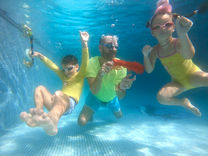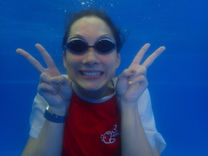Dry drowning: the child has choked on water, is he/she in danger?
A mum has written me an e-mail “I have a boy of three and a half and he loves water. I’m giving my best to take him to a swimming pool as often as I can. However, ever since I read an article about dry drowning, I’ve kept feeling uneasy. Every time now when he chokes on water, I can’t stop myself thinking about it for at least two days. I’ve got a feeling that if he chokes while in the water, that’s it... Is it really the case? How can I recognise dry drowning? How can I prevent this dry drowning? What can parents do in those situations?”
Dry drowning is a rather important topic parents should be aware of, but for the reason no to panic every time their child hiccups in the pool, water, river, lake… I’m a parent myself and I am also someone who’s been working with kids in the water for more than two decades, and my responsibility and caution are at a very high level, so I understand where your fear comes from every time your child hiccups…
Ever since I started working with baby swim lessons, I’ve encouraged parents to make their six-month-old babies or a bit older children dive. In many cases, even today, it is me who’s made those first dives with more than a thousand babies so far. I’ve always had a though of danger in my mind about possible side effects of it. At the same time, I was sure that I had done a sufficient number of preparatory lessons so that they could be ready and safe to make the first dives. This is why it is rather important to let the professionals make these first steps for you, so that you could enjoy swimming with your kids later, without having to worry about every single hiccup they make.
How can parents prevent the unwanted situations in the water?
First of all, the most important thing is to always be careful and you always keep an eye on your child, no matter if there are lifeguards on duty or you’re just visiting a friend who has a pool in the backyard. If something happens, and if the child is under surveillance of an adult, a timely reaction can recognise and prevent the worst scenario.
Of course, it is vital that parents and children can swim, breathe properly under water, but also know how to behave in and around the water, which is learnt in baby swim lessons at the very young age, or in groups of older children, when they get in touch with the water for the first time.
This is why prevention and education are of key importance not only for parents but for all of us who are in contact with water and convey a message about water and its benefits and dangers.
Drowning is defined as a breathing issue when water gets into the airway. It can also occur in some apparently harmless situations, but it is veeeery rare and you should relax and stop thinking about it, enjoy your time with your kid as he/she is swimming and playing in the water.
They are not often defined in detail. The stress is always on media “intimidation” without providing any clear guides for parents.
In dry drowning the water never enters the lungs. The water remains in the airways causing an irritation and spasm of muscles blocking a normal airflow and breathing and it can be easily identified right away, you don’t need to wait…
Secondary drowning happens when a person inhales water into his or her lungs. The water irritates the lungs and it happens that the amount of water and liquid increases, which is called a pulmonary edema . The symptoms are also visible right away as the child has difficulties in breathing and the situation can worsen in the next 24 hours.
The symptoms of dry drowning are: persistent coughing, chest pain, difficulty in breathing and the feeling of exhaustion and lethargy. Also, you can identify serious changes in your child’s behaviour, as the child becomes moody with very low energy, which can mean that the brain is not getting enough supplies of oxygen. If you identify these symptoms you should immediately ask for medical help.
Swim, be careful when your dearest ones are in the water and around it, but try to enjoy it a bit. Since life is more beautiful when you’re swimming!
I’m not a physician, but I’m writing about dry drowning? Preparing someone to become a coach, to work with children on the dry or in the water is all but an easy thing to do. It’s not enough to just love that sport, you also need to know what can happen to the organism or muscles, and why. This is why there is Anatomy as a subject at the first year of studies ,…I never skipped my classes. Of course, just after you leave school you realise that there’re a lot of things yet to be learnt. This is the reason why I revise the theory and practice on prevention and the basic life-saving skills every six months, and I keep up with the professional public, attend swimming seminars, etc.




















































Comments